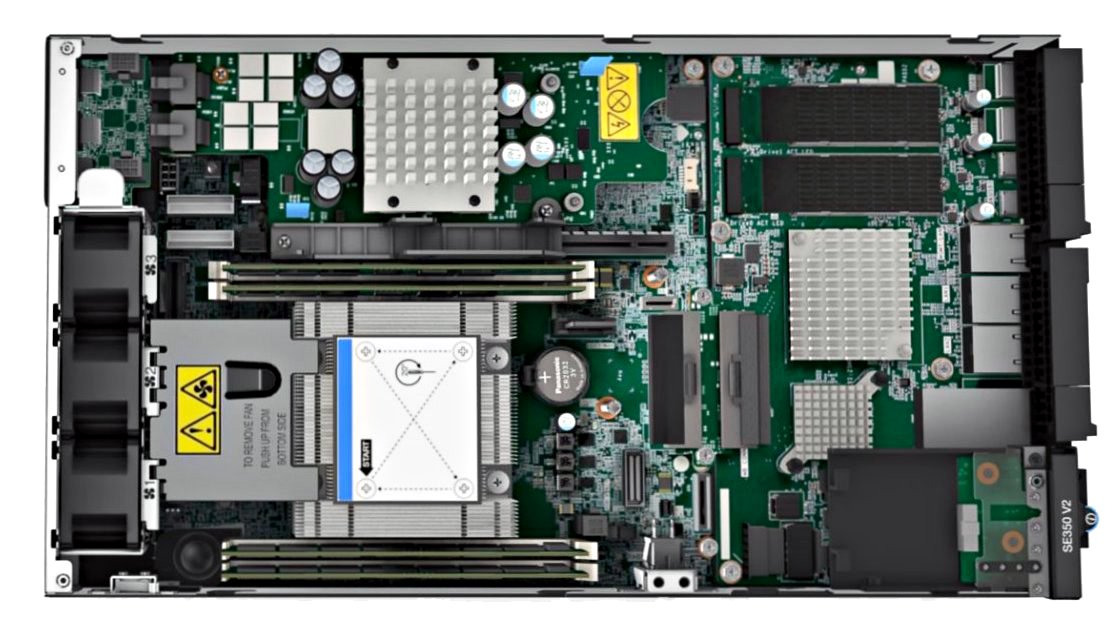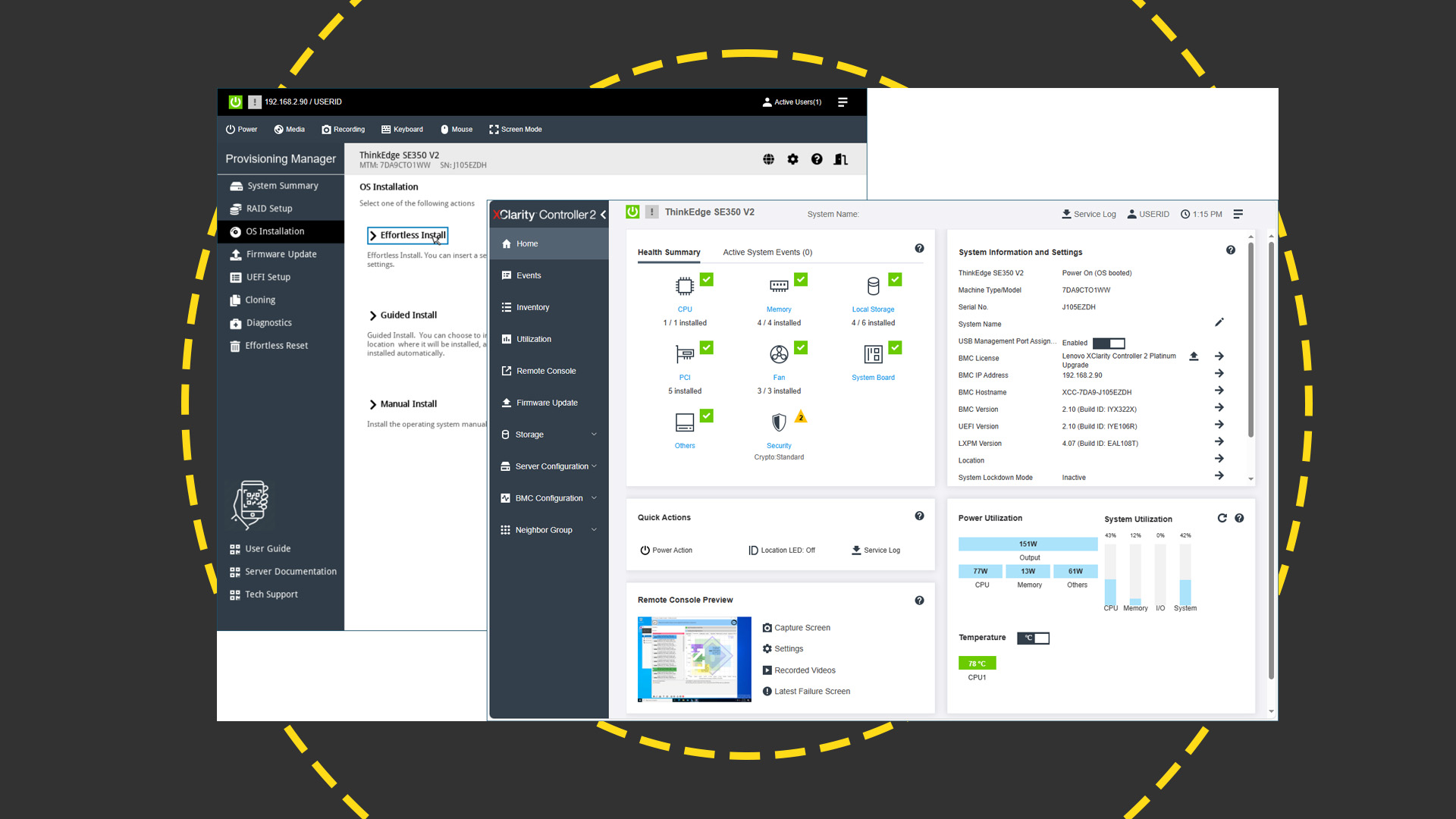Lenovo ThinkEdge SE350 V2 review: Lenovo ditches the frills to provide serious firepower to those tight on space
The SE350 V2 is a slim-line chassis that sports a more powerful D-2700 CPU and faster 3,200MHz TruDDR4 memory

-
+
Very compact chassis
-
+
Xeon D-2700 edge compute CPU
-
+
High memory capacity
-
+
Gigabit or 10/25GbE network ports
-
+
Supports SATA or NVMe drives
-
+
Remote management
-
-
No PCIe slots or Wi-Fi support

READ MORE

Lenovo laid its cards on the table when it launched the ThinkSystem SE350 four years ago as it was clear it was sharpening its focus on the burgeoning edge computing market. Since then it has released a range of new and innovative edge servers such as the SE360 V2, and the model that started it all now receives a major refresh.
The ThinkEdge SE350 V2 may look very similar to its predecessor but it introduces a heap of internal and external updates. It still employs the same slim-line chassis that measures a miniscule 21cms wide and 39cms deep but sports a more powerful D-2700 CPU and faster 3,200MHz TruDDR4 memory.
Storage sees big changes as Lenovo has moved the focus away from internal M.2 SSDs and more towards hot-swap drives. Two new chassis options are available so you can choose from four front-mounted 7mm SATA/NVMe SSDs or two 15mm models – M.2 SSDs haven't been dispensed with completely as there's still room inside for two NVMe SSDs which can be used as boot drives.
Lenovo ThinkEdge SE350 V2 review: Design and expansion
The solid metal chassis is very well constructed, is shock and vibration resistant, and designed to handle ambient temperatures up to 55 degrees C. An optional security bezel with an integral dust filter is available while Lenovo's node sleeve allows the server to be wall-mounted or fitted to a DIN rail.
You have a choice of three power options as models are available with one non-redundant pure AC input source, DC direct connections or dual 300W external PSUs, Choose the latter and you can use Lenovo's 1U2N brackets to fit two servers side by side in 1U of rack space with room at the back for the four PSUs while for shorter depth data cabinets, the 2U2N rail kit has the PSU mounting bracket above the two servers.

Removing the lid reveals a smartly designed interior with the CPU to the left, mounted by a large passive heatsink and flanked on each side by two DIMM slots. The main reason for this tidiness is the new drive bay cage doesn't leave room for any PCIe slots so the only expansion options are adding M.2 SSDs or upgrading memory.
Underneath the drive bay cage is an I/O daughter-card which determines the network configuration. Two choices are on offer as you can opt for dual 2.5GbE multi-Gig and either quad copper Gigabit or quad 10/25GbE SFP28 fiber ports.
Sign up today and you will receive a free copy of our Future Focus 2025 report - the leading guidance on AI, cybersecurity and other IT challenges as per 700+ senior executives
Lenovo ThinkEdge SE350 V2 review: Server management
There are no compromises for server management as the SE350 V2 is endowed with the same XClarity Controller (XCC) 2 chip and dedicated Gigabit port you'll find on Lenovo's larger ThinkSystem servers. The XCC Standard version provides features such as remote power controls, sensor monitoring, and inventory while a Platinum upgrade adds remote KVM, virtual media services, remote OS deployment, and power-capping plus the new Neighbour Group feature for managing multiple servers from one XCC interface.

The XCC's web console presents a wealth of information about critical hardware components along with device utilization graphs, plus hardware inventory, and firmware upgrade tools. OS deployment is a cinch as we used the XCC provisioning manager's Effortless Install option to load Windows Server 2022 from a mapped ISO file in 30 minutes with no further intervention required.
If you removed the drive cage, you may have noticed a microSD card slot sitting on the edge of the system board. This can be used to present extra storage to the XCC as a remote disk on card (RDOC) device and to store firmware updates.
RELATED WHITEPAPER

Physical security is good as the XCC console offers options to set actions for significant motion detection, step counting, and chassis intrusion. If any are triggered, you can set the server to go into lockdown mode or power itself off.
Centralized remote management of all Lenovo servers, storage arrays, and switches is provided by the XClarity Administrator app which we run in the lab as a Hyper-V VM. After adding the SE350 V2 to its console using its discovery process, we could remotely monitor it, control power, and employ an image library for firmware updates or OS deployments.
Lenovo ThinkEdge SE350 V2 review: Storage features
Storage options are pretty straightforward as you simply choose which hot-swap drive bay you want when ordering the system. As previously mentioned, you can have one with four 7mm bays or two 15mm bays.
The drive cage must be removed to install M.2 SSDs, although this a simple job as it's retained by four screws and lifts away easily. Along with the embedded network and USB ports, the I/O daughter-card underneath has two 2280-long M.2 slots ready and waiting.

Intel's embedded VROC (virtual RAID on CPU) controller handles all RAID management and in its base configuration only supports SATA devices and RAID0 and 1 arrays. To enable NVMe support, you must upgrade it with a Standard key (£148) which activates NVMe RAID10, or a Premium key (£475) for additional RAID5 support and these are applied from the XCC controller's web interface.
Lenovo ThinkEdge SE350 V2 review: Is it worth it?
The ThinkEdge SE350 V2 represents a major upgrade over the original ThinkSystem SE350 and looks comparatively good value. Lenovo's DCS Configurator website shows entry-level CTO (configure to order) models with a quad-core Xeon D-2712T CPU, 16GB of DDR4, and no storage selected starting at around £5,900.
It does lack expansion slots but this system is designed to deliver a lot more storage than the GPU-capable SE360 V2, its notebook-sized chassis is a lot smaller, and cooling demands are much lower. Businesses that are short on space at the edge and seeking a powerful server solution that'll fit in it will find the ThinkEdge SE350 V2 a worthy contender.
Lenovo ThinkEdge SE350 V2 specifications
| Chassis | 1U half-width, short-depth |
| CPU | 8-core 2.1GHz Intel Xeon D-2733NT |
| Memory | 256GB 3,200MHz TruDDR4 (max 256GB) |
| Storage | 4 x 7mm 3.84TB Micron U.3 NVMe SSDs (max 4), 2 x 2280 M.2 NVMe SSD slots |
| RAID | Intel VROC SATA (key required for NVMe support) |
| Network | 2 x 2.5GbE, 4 x 10/25GbE SFP28 |
| Expansion | No PCIe slots |
| Power | 2 x 300W external PSUs |
| Management | XCC 2 with Gigabit, XClarity Administrator |
| Warranty | 3Yr on-site NBD |
Dave is an IT consultant and freelance journalist specialising in hands-on reviews of computer networking products covering all market sectors from small businesses to enterprises. Founder of Binary Testing Ltd – the UK’s premier independent network testing laboratory - Dave has over 45 years of experience in the IT industry.
Dave has produced many thousands of in-depth business networking product reviews from his lab which have been reproduced globally. Writing for ITPro and its sister title, PC Pro, he covers all areas of business IT infrastructure, including servers, storage, network security, data protection, cloud, infrastructure and services.
-
 ‘1 engineer, 1 month, 1 million lines of code’: Microsoft wants to replace C and C++ code with Rust by 2030 – but a senior engineer insists the company has no plans on using AI to rewrite Windows source code
‘1 engineer, 1 month, 1 million lines of code’: Microsoft wants to replace C and C++ code with Rust by 2030 – but a senior engineer insists the company has no plans on using AI to rewrite Windows source codeNews Windows won’t be rewritten in Rust using AI, according to a senior Microsoft engineer, but the company still has bold plans for embracing the popular programming language
By Ross Kelly Published
-
 Google drops $4.75bn on data center and energy firm Intersect
Google drops $4.75bn on data center and energy firm IntersectNews The investment marks the latest move from Google to boost its infrastructure sustainability credentials
By Nicole Kobie Published
-
 OpenAI says prompt injection attacks are a serious threat for AI browsers – and it’s a problem that’s ‘unlikely to ever be fully solved'
OpenAI says prompt injection attacks are a serious threat for AI browsers – and it’s a problem that’s ‘unlikely to ever be fully solved'News OpenAI details efforts to protect ChatGPT Atlas against prompt injection attacks
By Nicole Kobie Published
